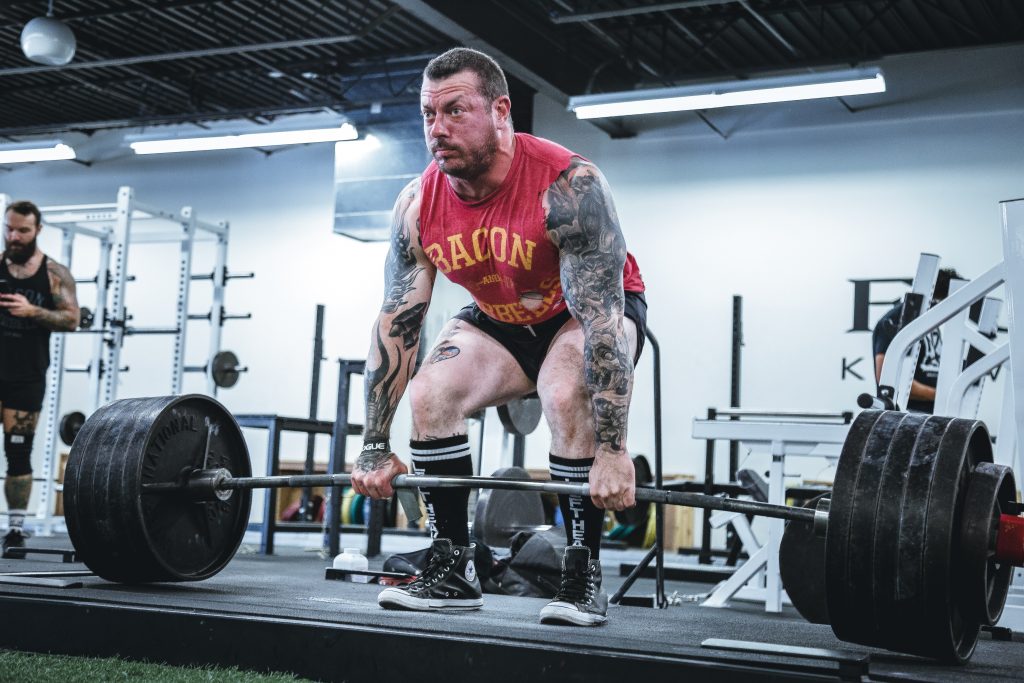When someone says the word “deadlift” to you, what do you picture? Think about it for a second.
Maybe this?

While the above picture is indeed a deadlift, it’s not the only variation.
That image is also what people think of when they hear the myth that deadlifts are bad for your back. It’s a myth that has been perpetuated in the fitness industry for far too long.
This idea—that deadlifting is bad for backs—is pushed by the media, friends and family, and even other fitness professionals. While telling someone that “deadlifts are bad for your back” may be a well-intentioned recommendation, as the person giving the advice likely just wants you to be safe, it does you a disservice… because it’s incorrect.
Deadlifts aren’t bad for your back, unless you do them poorly, or don’t use the variation best suited to you.
A deadlift is simply a hip hinge, and there are tons of hip hinge variations that don’t include a bar lifted from the floor. You can use different stances, elevate the bar, use a hex bar instead of a standard barbell, or even use kettlebells—like we do at BSP NOVA when folks are just learning the movement.
View this post on Instagram
Deadlifts, when done correctly, can be immensely valuable.
- building full-body strength and power
- building lean muscle
- teach us how to move effectively through our hips
Ever have to move furniture or pick up your kid/grandkid? Well, having the skill and strength to deadlift can help to both make these tasks easier and safer.
Deadlifting isn’t back for your back.
In fact, it’s good for it. Don’t take my word though, let’s look at what the research says.
A study from 2015 found deadlifts to be a useful treatment for those in back pain (1). The researchers said, “…regardless of patients’ age, sex, body mass index, pain-related fear of movement, movement control, and activity, the deadlift exercise seems to be an effective intervention.” So, not only was deadlifting not bad for people’s backs, it helped decrease their pain.
A separate study from 2012 also showed deadlifting improved a subjects functional status and decreased their pain (2).
One thing worth mentioning about these studies is some participants did not benefit from deadlifting in the same way; that is, their pain was not reduced. This is likely due to various factors: (a) a barbell deadlift was chosen in these studies, but maybe a kettlebell deadlift, or even a barbell RDL would have been a better fit depending on the individual; (b) the height of the bar was not elevated—at least, this was not stated—which would be a better fit for some individuals; (c) and since pain is multifactorial, not having a decrease in pain could mean other, more important factors, need to be examined. But, and I want to be clear here, that doesn’t not mean deadlifting was bad for them—only it wasn’t able to decrease their pain.
View this post on Instagram
Assuming there are no preexisting issues to consider, nearly everyone will benefit from deadlifting. So long as you lift with good form—keep your spine neutral (tall and tight), have hamstring tension, and produce the motion using your hips, not your lower back—you’ll be fine. That last part about form is key: the weight is moved by the legs and hips, not the lower back. This ensures we stress areas we want to stress (our lower body), and don’t stress other areas (lower back).
So, we clear on that? Deadlifting isn’t one thing—lifting a heavy bar from the floor—and, it can be good for your lower back; it’s not a lower back destroyer as many claim it is. If you pick variations that make sense for you, load appropriately, progress the weights overtime in a reasonable manner, and ensure the use of proper form, then deadlifts are a relatively safe and beneficial exercise; they don’t need to be feared.
Sources:
1) Berglund, Lars, et al. “Which patients with low back pain benefit from deadlift training?.” The Journal of Strength & Conditioning Research 29.7 (2015): 1803-1811.
2) Holmberg, David, Henrik Crantz, and Peter Michaelson. “Treating persistent low back pain with deadlift training–A single subject experimental design with a 15-month follow-up.” Advances in Physiotherapy 14.2 (2012): 61-70.
